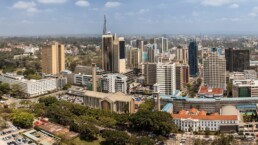Share
Most of Africa lags the rest of the world in key infrastructure metrics, such as energy, road and rail transportation, and water supply. According to NEPAD, only 38% of the African population has access to electricity, whilst only 25% of roads on the continent are paved. As a consequence, there is a 30% to 40% cost burden on all Intra-African trade.
Geographic Information Systems (GIS) can help governments rebuild and meet the socioeconomic needs of citizens.
A Geographic Information System (GIS) is a framework for gathering, managing, and analysing data. Rooted in the science of geography, GIS integrates many types of data. It analyses spatial location and organizes layers of information into visualizations using maps and 3D scenes.
GIS has become a part of our everyday life. Whether we are obtaining a list of nearby restaurants, checking traffic or public transportation schedules. Without a doubt, GIS has made our lives easier, not just for ordinary citizens but businesses and governments have also reaped the benefits.
The ability to make maps that communicate, perform analysis, share information, and solve complex spatial problems has proven to be critical.
A study conducted by the World Bank titled Africa’s Infrastructure: A Time for Transformation, stated the following: “The prices paid by African consumers for infrastructure services are exceptionally high by global standards. The tariffs charged in Africa for power, water, road freight, mobile telephone, or Internet services are several multiples of those paid in other parts of the developing world. There are two explanations that exist for Africa’s high prices: First, the cost of providing infrastructure services in Africa is genuinely higher than elsewhere because of the small scale of production, the reliance on suboptimal technologies, or the inefficient management of resources. Second, the high prices reflect high profit margins caused by the lack of competition in service provision and inadequate price regulation”.
Africa’s infrastructure deficit is stunting it´s socioeconomic development, but it is also an opportunity for innovative solutions to step in to address the challenges. In Africa so far, GIS has been successfully implemented to monitor environmental issues associated with agriculture, fishing, and forestry. However, GIS has largely been neglected in infrastructure management. So why is GIS technology so important for infrastructure development?
Asset management
Monitoring infrastructure is extremely challenging. The use of GIS in the management of public infrastructure allows local governments to develop data-based proactive asset management plans in-line with community needs. A GIS framework enables accurate resource allocation by facilitating holistic evaluations of where infrastructure upgrades may be needed and possible time frames. The World Economic Forum global competitiveness report for 2017-2018 revealed that Nigeria has one of the least maintained road networks in Africa. GIS would certainly help formulate maintenance plans by providing a holistic overview of the country´s highway infrastructure and where gaps exist.
A study by BMC Public Health revealed that by 2050, sub-Saharan Africa’s urban population is expected to grow from 414 million to over 1.2 billion. This growth will likely compound the challenges faced by municipalities in attempting to provide access to clean water and sanitation. Cities such as Lomé and Maputo are grappling under the pressure of exponential population growth. Insufficient sewage systems are often a catalyst for disease outbreaks such as cholera and typhoid.
Presently, municipalities across the world employ Hydraulic and hydrologic modelling to analyse water and sewer networks for urban centres. Although this modelling method has been used since the 1970s, recently we have seen it coupled with GIS, and this has enabled improved water supply mapping by producing high-quality aerial maps with greater accuracy.
In Côte d’Ivoire, coastal degradation is leading to increased instances of flash flooding which the World Bank has reported to be costing the country at least USD2 Billion in damages with countless lives lost, and the problem is likely to get worse as a result of climate change.
The advancements brought by GIS mapping allows for enhancements to be made in the Flood Resilience strategies of human settlements. Meteorological data, in tandem with GIS can identify areas that are prone to flooding. This allows for drainage networks to be designed accordingly. Therefore, protecting other critical infrastructure such as electricity lines and roads, as well as preserving precious human lives.
Impact assessment
With GIS, we can assess the impact infrastructure is having on a given location. In South Africa´s Western Cape province, a history of racial segregation resulted in an acute shortage in housing, which has had the unintended consequence of creating informal settlements around transportation networks. This is because accessibility to transportation facilitates easier access to places of employment.
The Western Cape provincial government, together with stakeholders in the technology sector, developed a database to provide information on the demand and supply of land for the provisioning of low-income housing, leveraging GIS.
Infrastructure has a tremendous impact on the environment. Cities such as Lagos and Port Harcourt in Nigeria have witnessed deterioration in air quality due to rapid urbanization. The population in our African urban centres is expected to grow exponentially over the next decade, thus the need for alternative clean energy is more imperative than ever.
A study was conducted by The Indonesian Geographers Association on the air quality in these 2 cities, utilizing data from portable remote gas detectors and GIS mapping,
The quantities of pollutants in the atmosphere were found to be well above maximum levels allowable under WHO guidelines. The most affected communities were those residing near major freeways.
Infrastructure planning
Infrastructure planning is critical to economic development. Maps generated from GIS helps plan and analyse a city´s infrastructure needs. Application of GIS can significantly reduce operational and administrative costs.
To highlight the importance of this we can look at the following case study: The Council of Scientific Research in South Africa (CSIR) produced an academic paper on “School Accessibility in the City of Tshwane, South Africa”. There is a critical shortage of classrooms for primary and secondary schools in South Africa. The average learner to teacher ratio of schools is roughly 30:1.
Combining GIS mapping and census population data, immense errors were discovered in the distribution of schools in the metropolitan area. This was due to the locations of schools being initially captured inconsistently. Such anomalies can result in the provision of education resources (such as building a new school) where it may not be necessary and deprive those areas where they may be a genuine need. Thus, this greatly improved resource allocation the provision of education and ensured equitable distribution of classrooms.
For years, the bustling capital of Ethiopia, Addis Ababa, has seen illegal housing being built haphazardly in most parts of the city, which has created an administrative nightmare for urban planners.
To mitigate this, the city council developed a database to catalogue all human settlements leveraging GIS mapping and manual data collection. The primary objectives were to improve urban development planning and service delivery. Tax authorities were also quick to take advantage of this innovation. The City´s Finance Bureau conducted comprehensive audits of property taxes and exponentially increased revenue collection. GIS mapping assisted auditors to identify property owners who were not paying tax and mitigated opportunities for fraudulent misrepresentation of assets.
The Future
This piece has highlighted GIS applications in an urban landscape. In some parts of the world, local governments have turned to GIS to develop infrastructure in rural areas. Significant investments have been made by the European Space Agency under the programme Connected Rural Communities. One of the objectives of the programme is to improve transportation and mobility in rural areas for economic development. The anticipated benefits will be tourism growth, job creation and industrialization.
A 2018 report by the Infrastructure Consortium for Africa (ICA) revealed that between 2013 and 2017, the average annual funding for infrastructure development in Africa was $77 billion. The transport and energy sectors together accounted for nearly three-quarters of the total investment. As the continent goes through a phase of rapid population growth, financing for infrastructure will increase likewise. In light of the above, the involvement of GIS in Infrastructure development projects will certainly become more relevant.
The views expressed in this article are those of the author alone and not the Future Africa Forum.
The views expressed in this article are those of the author and do not necessarily reflect the views of Future Africa Forum. Future Africa Forum is a pan-African policy think-tank and policy advisory consultancy headquartered in Nairobi, Kenya.



